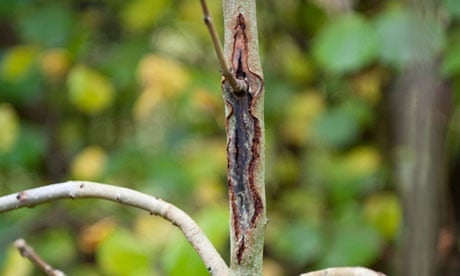Ash dieback

Ash dieback, also known as Chalara dieback of ash, is a serious disease that is killing ash across Europe. Ash is a very important tree in the UK both ecologically and culturally so this disease is causing great concern about the damage it will do.
Symptoms
- Dark lesions – often long, thin and diamond-shaped – appear on the trunk at the base of dead side shoots
- The tips of shoots become black and shrivelled
- Blackened, dead leaves – may look a bit like frost damage
- The veins and stalks of leaves, normally pale in colour, turn brown
- Saplings have dead tops and side shoots
- In mature trees, dieback of twigs and branches in the crown, often with bushy growth further down the branches where new shoots have been produced
- In late summer and early autumn (July to October), small white fruiting bodies can be found on blackened leaf stalks.
Causes
- The disease is spread by spores from the fruiting bodies of the fungus produced on fallen ash leaves. These airborne spores can disperse naturally via wind over tens of kilometres
- Prior to the ban in October 2012 on the movement of ash trees, spread over longer distances was likely to have been via the movement of infected ash plants.
Outlook
- The disease is spread by spores from the fruiting bodies of the fungus produced on fallen ash leaves. These airborne spores can disperse naturally via wind over tens of kilometres
- Prior to the ban in October 2012 on the movement of ash trees, spread over longer distances was likely to have been via the movement of infected ash plants
- We don’t know what the full impact of ash dieback will be. Evidence suggests young trees are killed quickly while many mature ash trees can resist infection for some time until eventually dying or becoming weakened and succumbing to attack from another pest or pathogen.
- Scientists have developed techniques to identify individual trees that are less susceptible to ash dieback disease, this technique combined with resistance breeding trials, can be used to grow trees that are more likely to survive the disease.
